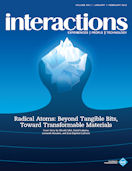Authors:
Rhett Russo, Katrin Mueller-Russo, Clemens Winkler, Kärt Ojavee, Eszter Ozsvald, James Charlton, Nico Refiti
Our interest in the traditional Chinese ceramic tea stool influenced the design of the T-Stool. The design is based upon the cylindrical form of a hollow vessel, which is strong in compression. Textile played an important role during the fabrication process. The form is generated through the manual folding of a flat textile into a hollow three-dimensional volume. This transformation has been complemented by the use of digital tools, and our implementation of the textile as a device to produce a singular structural shell in ceramic.

Photo by Rhett Russo (© Specific Objects)
 Authors
Authors
Rhett Russo
New Jersey Institute of Technology | [email protected]
Katrin Mueller-Russo
Pratt Institute | [email protected]
The woven textile called Tensed Up is laced with conductive and synthetic yarns, capacitors, and diodes. This project shows the connections between new materials, digital media, and human perception. The material detects the electrical energy in the surroundings and responds by stiffening, producing an effect similar to hairs standing on end.

Project website: http://clemenswinkler.com
Publication: Winkler, C. Unter Strom/tensed up. VDM Publishing, Saarbruecken, Germany, 2010.
Photo by Clemens Winkler
 Authors
Authors
Clemens Winkler
University of Kassel | [email protected]
SymbiosisO is a collection of textile interfaces. The form, function, and aesthetics are designed to mimic the multi-layered structures of living organisms.
SymbiosisW is a three-dimensional material that senses human touch. The material responds by revealing small cell patterns that start to grow when touched by a person's hand. The motif spreads by keeping one's hand against the material. It is also possible to create a desired arrangement of patterns.

Project website: http://www.symbiosiso.com/
Photo by Anu Vahtra
 Authors
Authors
Kärt Ojavee
Centre for Biorobotics, Estonia | [email protected]
Eszter Ozsvald
Tisch School of the Arts/ITP | [email protected]
When participants with iPhones move through the landscape, the movement generates from GPS data a stereo-lithographic sculpture produced from a performative sculpture. Through a process of transcoding, iForm explores the construction and perception of time-based events as a means of examining the ability of a static object to encapsulate temporalspatial information. iForm aims to question our relationship with physical objects by proposing a modality for representation in which the linear codex of time-based perception is challenged.
The project uses the iPhone app Comob that was developed in a joint research project between the Edinburgh College of Art, the University of Edinburgh, and the University of Lancaster.

Project website: http://www.idot.net.nz
 Authors
Authors
James Charlton
AUT University | [email protected]
Nico Refiti | [email protected]
©2012 ACM 1072-5220/12/0100 $10.00
Permission to make digital or hard copies of all or part of this work for personal or classroom use is granted without fee provided that copies are not made or distributed for profit or commercial advantage and that copies bear this notice and the full citation on the first page. To copy otherwise, to republish, to post on servers or to redistribute to lists, requires prior specific permission and/or a fee.
The Digital Library is published by the Association for Computing Machinery. Copyright © 2012 ACM, Inc.








Post Comment
No Comments Found